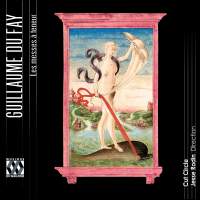Texte paru dans: / Appeared in: |
|
|
Outil de traduction ~ (Très approximatif) |
|
|
Reviewer: J.
F. Weber We now have nine Masses on records that are attributed to Guillaume Du Fay (1397–1474), not counting the anonymous Missa Caput (Fanfare 20:4, now on Helios), which was published as his work in Besseler’s Opera Omnia. In addition to Missa Sancti Antonii de Padua (Besseler’s “Viennensis,” 31:5, now on Helios), the Missa Sancti Antonii Abbatis (the real “Viennensis,” 29:1), and the dubious Missa Puisque je vis (27:2, now on Helios), there are two early Masses dating from the 1420s: Missa sine nomine, now found to be based on the tune “Revelliés vous” (30:3), and Missa Sancti Jacobi, a plenary Mass (22:2 and 31:6). Finally, there are these four middle to late works, the most frequently recorded of all the Masses on this list. All four have been given exemplary performances by this new American unaccompanied vocal ensemble directed by a Stanford professor, using eight mixed voices with countertenors that blend perfectly with the other voices. Their first recording, De Orto / Josquin (37:1), demonstrated a mastery of programming, interpretation, and performance that immediately made them an ensemble to watch for. It featured the first recording of a Missa L’homme armé by Marbrianus de Orto, a colleague of Josquin Des Prez in the Sistine Chapel Choir. Missa Se la face ay pale, based on the more familiar of two settings of this song by Du Fay (it is heard first on the record), was the first Du Fay Mass to appear on records, though only the Kyrie was recorded by Safford Cape in 1936. The complete Mass was not recorded until 1963, but it has by far the most recordings of all the Du Fay Masses. The date of composition has long been debated, since it was apparently a wedding Mass and Du Fay wrote the song for the wedding of Louis of Savoy and Anne of Lusignan in February 1434. The Mass has also been dated to one of two later Savoy weddings in 1451 and 1452, but Anne Walters Robertson (in Journal of Musicology, 2010) dates it rather to the acquisition of the Shroud of Turin by the House of Savoy early in 1453, the “pale face” being that of Christ. It may be noted that this is the only one of these four Masses recorded by Andrew Kirkman (32:5), who has also made excellent versions of several of the least familiar Masses noted above. Missa L’homme armé has a similar connection between the secular song and a sacred motif. At the court of Burgundy, the song became a theme for the Order of the Golden Fleece and its forlorn attempts to organize one more crusade for the liberation of the Holy Land. But Craig Wright (in The Maze and the Warrior, 2001) made a strong case for Christ as the Armed Man. Roger Blanchard recorded it in 1956, and a decade later Alden Gilchrist made the first unaccompanied version—and the first American interpretation—of any Du Fay Mass. Both of these Masses were recently recorded by Giuseppe Maletto (38:5), basing his interpretation on the most recent understanding of both Masses. His disc, with accompanied singing, is a useful alternative to Rodin’s interpretations. Missa Ecce ancilla, as it was titled in Besseler’s edition, is now known in Alejandro Planchart’s Opera Omnia by the two chant antiphons for the feast of the Annunciation that furnish cantus firmi for the work. It was composed not later than 1464 after Du Fay had returned to Cambrai and his final position as a canon of the cathedral. According to the acta of the Cambrai cathedral chapter, no instruments were allowed in the cathedral of Cambrai. The precise interpretation of this has recently been questioned, but only Miroslav Venhoda and René Clemencic have recorded this Mass with instruments. Missa Ave regina caelorum is based on the composer’s third motet on this chant antiphon, which precedes it on this record along with the chant antiphon as well. It was very likely composed for the dedication of the cathedral on July 5, 1472. As it happens, there was also a coupling of these two Masses. Venhoda made the first recording of both Masses in 1968, using more instruments than singers (CD in 13:5). Planchart recorded Missa Ave regina caelorum twice: with a few instruments in 1970 and then unaccompanied in 1981, using an edition that anticipated his Opera Omnia. Clemencic, Eva Lebherz-Valentin, and Maletto have also used instruments in this final Mass. Rodin’s
tempos are brisk, consistently the fastest on record, yet the voices respond
so well to his direction that there is no sense of being rushed. Comparisons
with other unaccompanied recordings are instructive. Dominique Vellard in
the last two Masses and the Hilliard Ensemble in the two earlier Masses have
been touchstones, but Rodin’s livelier readings are another way of
appreciating this masterly music. Missa Se la face has recently had the best
reviews of the four Masses: Antoine Guerber (28:4), the Hilliards (32:1),
and Kirkman (32:5, as noted above) all earned warm commendation, but that is
only one of the four Masses packaged here. Rodin’s notes concentrate on
details of harmony, rhythm, text setting, and vocal interplay with readouts
from the timer to make it easier to hear them. The discs are slipped into
the board covers of a 60-page book of ordinary CD size, now normal for this
label. It is lavishly illustrated with seven illuminated manuscript pages
and a contemporary Flemish “Annunciation.” This is the most splendid early
Renaissance recording in some years, an absolutely essential acquisition for
every collector. | |
|
|
|
|
Cliquez l'un ou l'autre
bouton pour découvrir bien d'autres critiques de CD |
|




